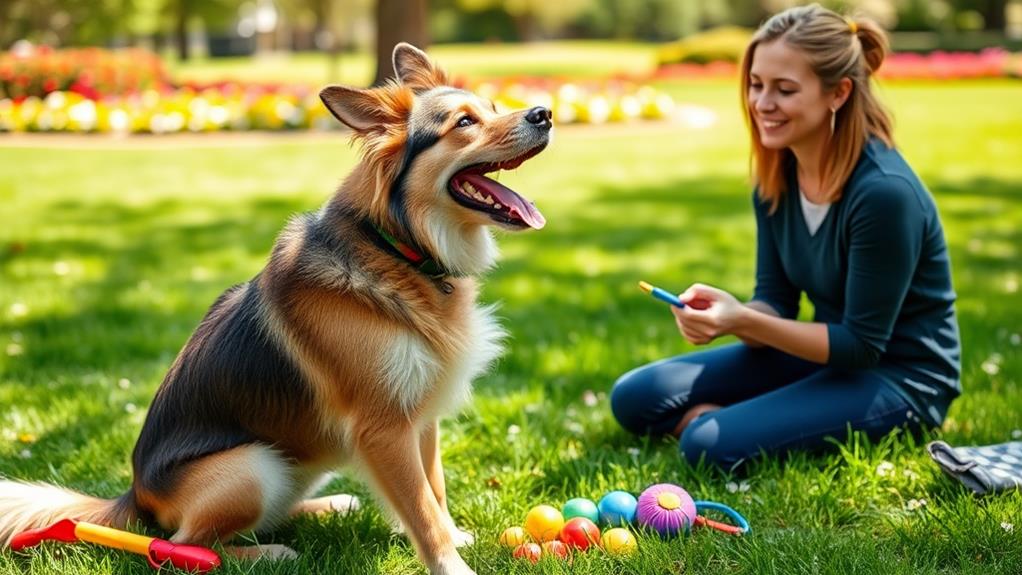To master clicker training, start by understanding the basics of positive reinforcement. Choose a clicker that feels comfortable and has a sound you like. Begin training with simple commands like "sit" or "stay" while using high-value treats to keep your dog motivated. Click at the exact moment your dog performs the desired behavior to create a strong association between the click and the reward. If you encounter challenges, adjust your approach and limit distractions. With these steps, you can build a strong bond and effective communication with your dog. There's even more to explore about enhancing your techniques!
Understanding Clicker Training
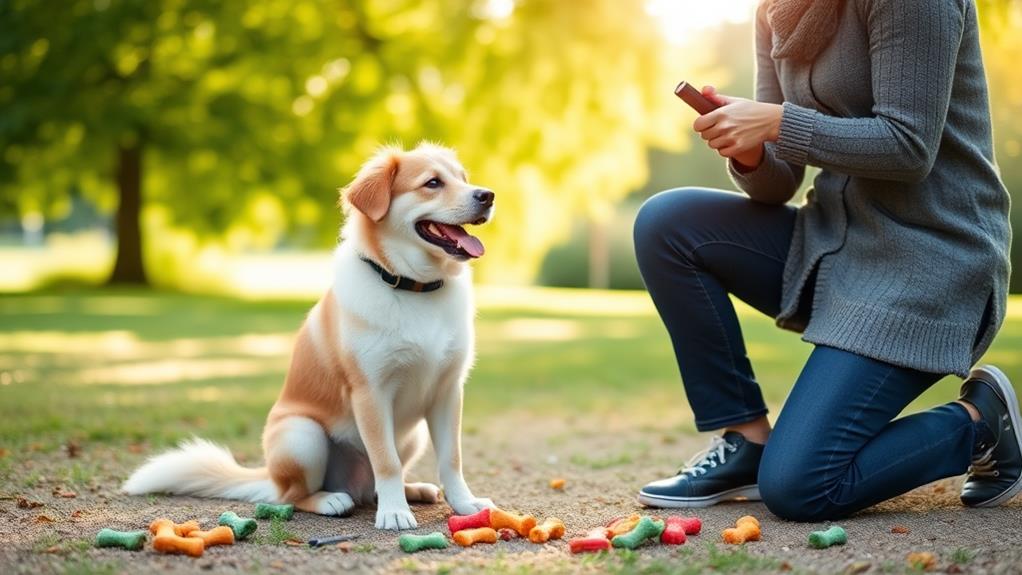
Clicker training is a powerful tool for dog owners looking to effectively communicate with their pets. At its core, clicker training relies on positive reinforcement, which means you're rewarding your dog for desired behaviors. By using a clicker, a small device that makes a distinct sound, you can mark the exact moment your dog performs the behavior you want. This helps your dog quickly understand what they're being compensated for.
To get started, you need to establish a clear connection between the click sound and a reward, typically a treat your dog loves. When your dog hears the click, they should immediately associate it with something positive. This method works because it captures your dog's attention and reinforces learning in a fun way.
As you practice, you'll notice your dog becoming more engaged and enthusiastic to learn. Consistency is key; always click and reward the moment your dog performs the desired action. Over time, your dog will start offering those behaviors more frequently, making training sessions enjoyable for both of you. Embrace the process, and watch your bond with your furry friend grow stronger through effective communication!
Choosing the Right Clicker

When it comes to choosing the right clicker for your dog, you'll find a variety of options available. The first thing you should consider is the sound. Some clickers produce a louder, sharper sound, while others offer a softer tone. Think about your dog's sensitivity; a softer click might be less startling for a timid pup.
Next, pay attention to the size and shape of the clicker. You want one that fits comfortably in your hand, allowing you to click easily during training sessions. Some clickers come with wrist straps or attachments, which can be handy if you prefer to keep your hands free.
You'll also want to look at the durability of the clicker. A sturdy model will withstand drops and rough handling. If you're training in various environments, consider a waterproof option.
Lastly, decide whether you want a traditional clicker or a more advanced version with features like adjustable volume. Choose one that aligns with your training style and your dog's needs, ensuring you both enjoy the process of learning together!
Basic Clicker Training Techniques
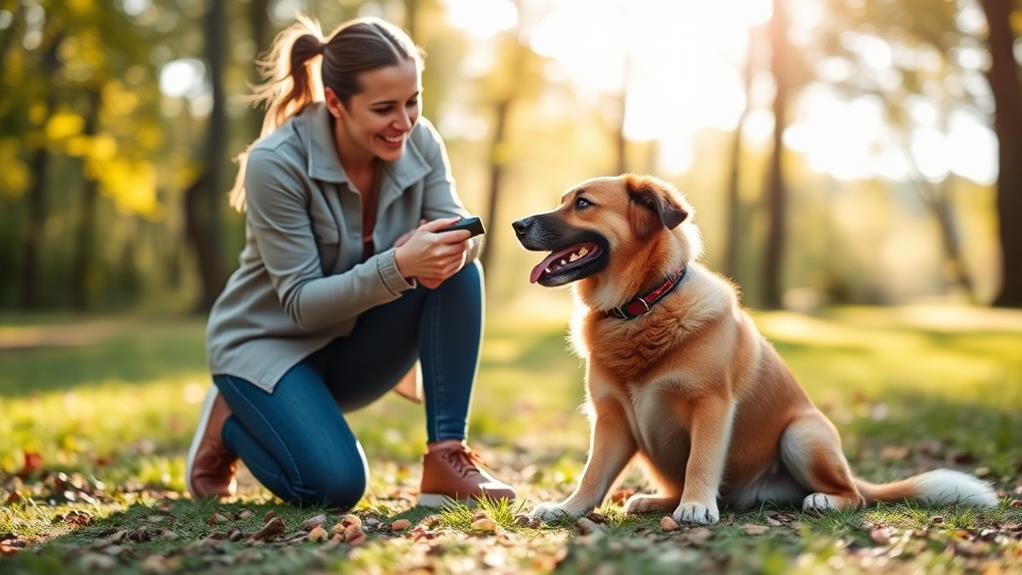
Understanding how to use your clicker effectively is key to successful training. Clicker training is all about timing and communication. To start, you'll want to establish a clear association between the click sound and a positive outcome for your dog.
Here are some basic techniques to keep in mind:
- Start with simple commands: Teach your dog basic commands like "sit" or "stay." Use the clicker immediately when your dog performs the desired behavior.
- Use high-value treats: Keep your dog motivated with treats they love. This encourages them to engage and respond to your clicks.
- Practice regularly: Consistency is vital. Short, frequent training sessions will help reinforce learning and maintain your dog's interest.
Reinforcing Desired Behaviors
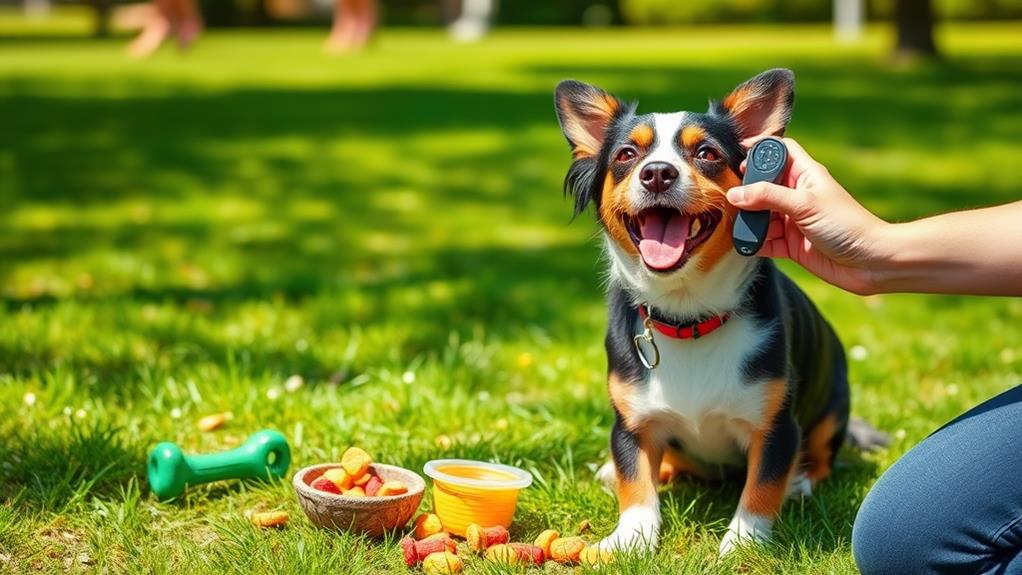
Reinforcing desired behaviors is essential for effective clicker training, as it helps your dog make clear connections between actions and rewards. When your dog performs a behavior you want to encourage, immediately click the clicker and follow it up with a reward, such as a treat or praise. This timing is key; your dog needs to associate the click with the specific action they just completed.
Start with simple commands like "sit" or "stay." When your dog successfully follows your command, give that click and treat right away. This immediate feedback reinforces the behavior you want. Consistency is also indispensable. Use the same commands and rewards each time to avoid confusion.
As your dog begins to understand what you're asking, you can gradually increase the difficulty of the tasks. Remember to keep sessions short and fun; this keeps your dog engaged and enthusiastic to learn. If your dog doesn't respond as you'd like, go back to basics. Reinforcing desired behaviors takes patience and practice, but with consistency and positive reinforcement, you'll see progress and strengthen your bond with your furry friend.
Troubleshooting Common Challenges
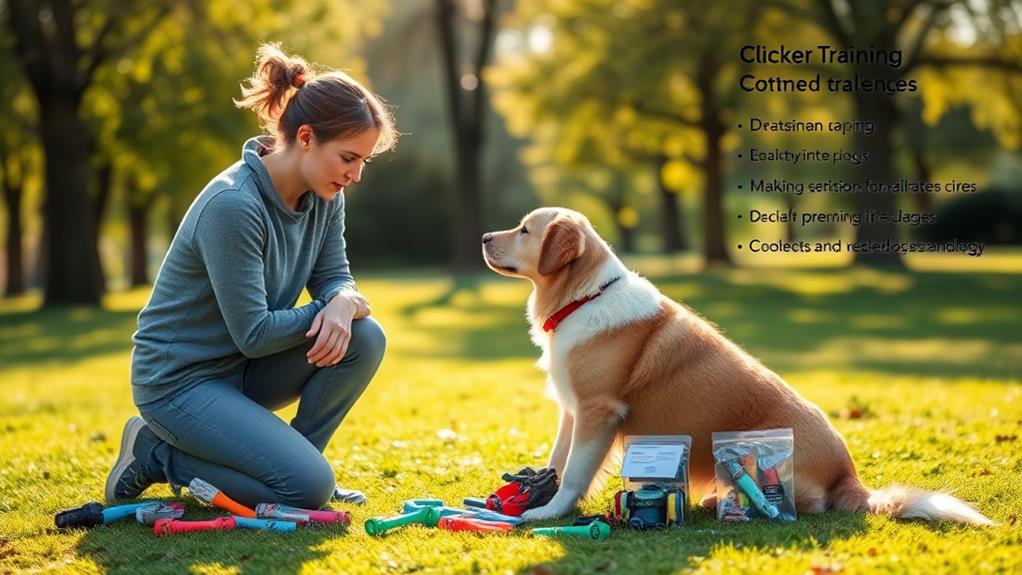
Even with the best intentions and techniques, you might encounter some challenges during clicker training. It's crucial to recognize these issues and address them to keep your training effective and enjoyable for both you and your dog.
Your dog doesn't respond to the clicker: This might mean they're not associating the click sound with a reward. Guarantee to practice in a distraction-free environment until they understand the connection.
Frequent distractions: If your dog gets distracted easily, try to train in a quieter area or limit distractions. Gradually increase the difficulty as your dog becomes more focused.
Inconsistent clicking: Certify that you're clicking at the right moment. If you click too late or too early, your dog may not understand what behavior you're reinforcing. Practice timing to improve your accuracy.
Frequently Asked Questions
Can Clicker Training Work for Older Dogs?
Absolutely, clicker training can work for older dogs! They can learn new behaviors and reinforce good habits. Just be patient, use positive reinforcement, and adapt your approach to their unique needs and abilities.
How Long Should Each Training Session Last?
Training sessions shouldn't feel rushed but also shouldn't drag on. Aim for about 5 to 15 minutes; that way, you keep your dog engaged without overwhelming them. Quality over quantity makes all the difference!
Is Clicker Training Suitable for All Dog Breeds?
Yes, clicker training's suitable for all dog breeds. It's effective because it relies on positive reinforcement, making it adaptable to each dog's personality and learning style. You'll see great results with consistency and patience.
Can I Use Treats Other Than Kibble?
Absolutely, you can use treats other than kibble! Many dogs respond well to small pieces of cooked chicken, cheese, or even commercial training treats. Just guarantee they're healthy and appropriate for your dog's diet.
What Should I Do if My Dog Ignores the Clicker?
If your dog's ignoring the clicker, try changing your timing or distance. Sometimes, a more enticing treat can capture their attention. Stay patient; chances are, they'll soon connect the sound with rewards you offer.
Conclusion
By mastering clicker training, you're not just teaching your dog; you're building a bridge of communication between you two. Each click is a stepping stone, guiding them toward desired behaviors and strengthening your bond. As you navigate this rewarding journey, remember that patience and consistency are your best allies. So grab your clicker and start your adventure—watch as your dog blossoms into the well-behaved companion you've always dreamed of!

